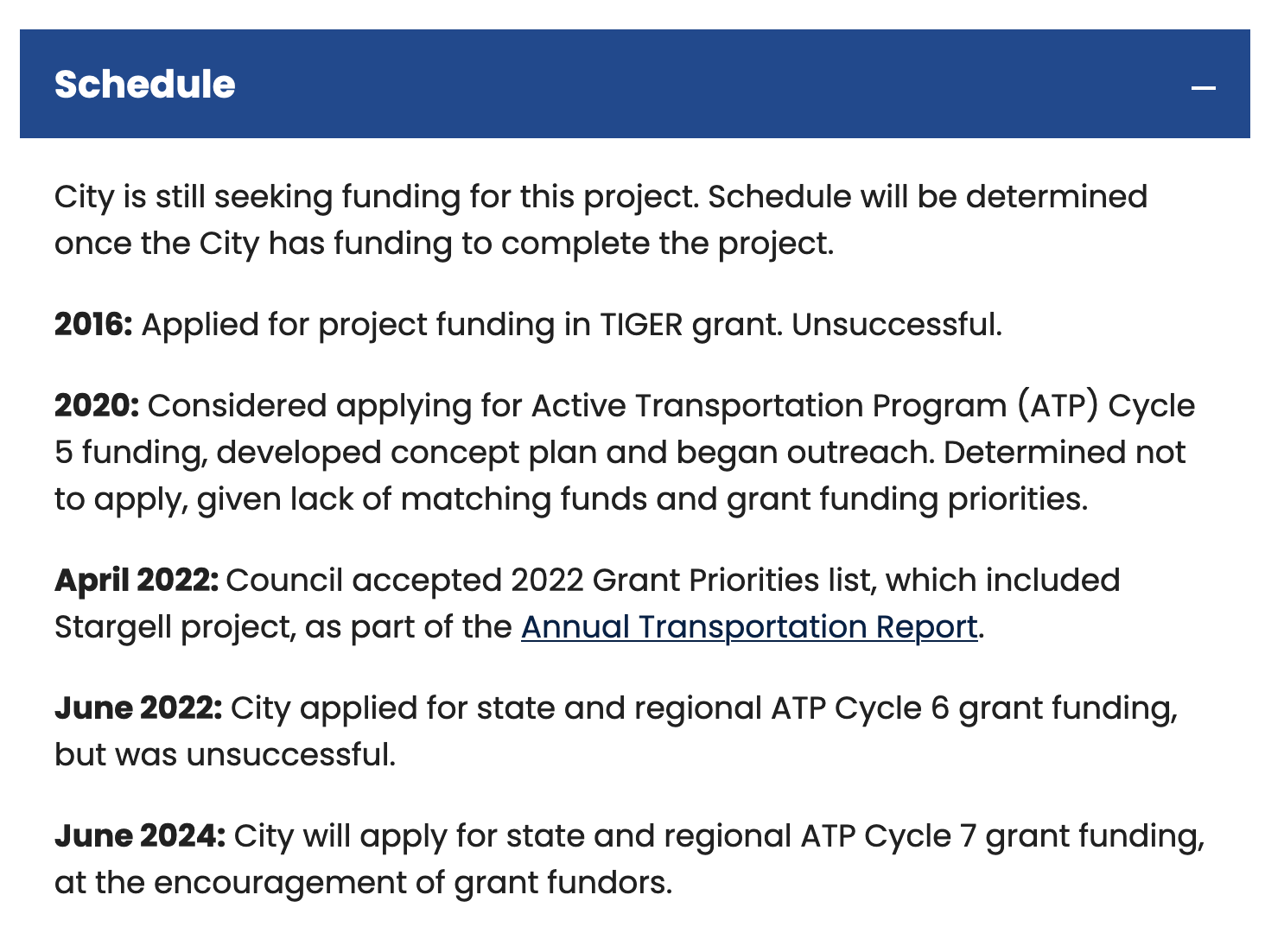Last week's Alameda city Transportation Commission included a presentation by staff about a grant application the city is submitting to make improvements to Willie Stargell Avenue.
Stargell Ave is a strange street. It starts with 4 lanes of auto traffic in its eastern portion next to the nearby shopping center. But as it heads west toward Alameda Point, Stargell Ave instantly reduces to 2 lanes of auto traffic, alongside a fallow strip of land.
This transition is visually apparent in the off-kilter geometry of the intersection at Stargell Ave and Fifth Ave:

This public right-of-way was, at one time, planned to serve as a continuous arterial road of 4 auto travel lanes to get cars into and out of Alameda Point. It's probably to our overall benefit that a larger arterial road was never actually realized here. That would have just created a "car sewer" moving drivers from Alameda Point to the Oakland tubes — without any care for all the other people who live or walk or bicycle in between.
Still, in the meantime, this corridor has sat under-realized. It's a subpar experience that encourages drivers to speed and doesn't provide much benefit to people on foot or bike, or people waiting for a bus.
Applying and re-applying to win
City staff have tried over the years to secure grant funding to build a "complete street" that solves these problems. They're trying again right now:

Applying for competitive grants is hard — and still it's worth doing, often times repeatedly.
(That's one of the reasons why I've repeatedly asked whether the City of Alameda would benefit from allocating additional staff positions to transportation: being able to apply — and re-apply — for even more grants.)
City staff said that their 2022 application for Stargell Ave was scored just under the threshold for winning applications — so it's definitely worth trying again.
For competitive grants, you gotta play — err, apply — in order to win...
Cooperating for all applicants' benefit
At the same time as Alameda is trying its best to stand out amid all the other Bay Area cities applying for these funds, let's do our part to cooperate to preserve the size of the pot of funds.
Unfortunately, the governor and Caltrans leadership regularly target the state-wide Active Transportation Program (ATP) for cuts.
Last year, the governor initially proposed a $500 million cut to the ATP — it was only after advocates and state legislators made noise that this funding was restored.
This year, it's happening again. In his May Revise, the governor proposes to cut $600 million from the ATP. If enacted, that cut will effectively mean the state-wide ATP program can't award grants to cities for projects like the proposed Stargwell Ave improvements... for the equivalent of two years!
What's most frustrating is that these proposed cuts to the ATP aren't happening in the context of overall cuts to transportation programs. Caltrans isn't facing other budget cuts. The giant pots of money that fund highways are not being cut. It's just the comparatively much smaller pot of money for "active transportation" projects that is first on the list to be cut each year.
I won't go so far as to say that Caltrans and CalSTA and the Governor's office actively dislike cycling projects and pedestrian safety projects. It's just that they apparently see those physical fixes and improvements roadways as "nice to have" optional activities, rather than part of the "bread and butter" of providing a safe and efficient surface transportation network to all Californians.
At the same time as they direct these budget cuts toward bike/ped safety projects, it's wild to see the director of Caltrans (and the secretary of the overarching CalSTA agency) speaking about the potential for "generative AI" software to improve traffic safety. With all due respect to them, whatevs.
Anyway, what really matters is the pots of money for funding real transportation improvements on the ground.
So, for the second year in a row, it's up to us at the local level to contact our elected leaders in Sacramento — and tell them how important it is to maintain the Active Transportation Program's pot of money.
Last year they easily found a way to make it work, once state lawmakers saw how many constituents cared. They can figure it out again this year.
I encourage you to use this form from CalBike to contact our legislators and ask them to preserve the Active Transportation Program funds in the same way that all other road-related transportation funds have been held steady.